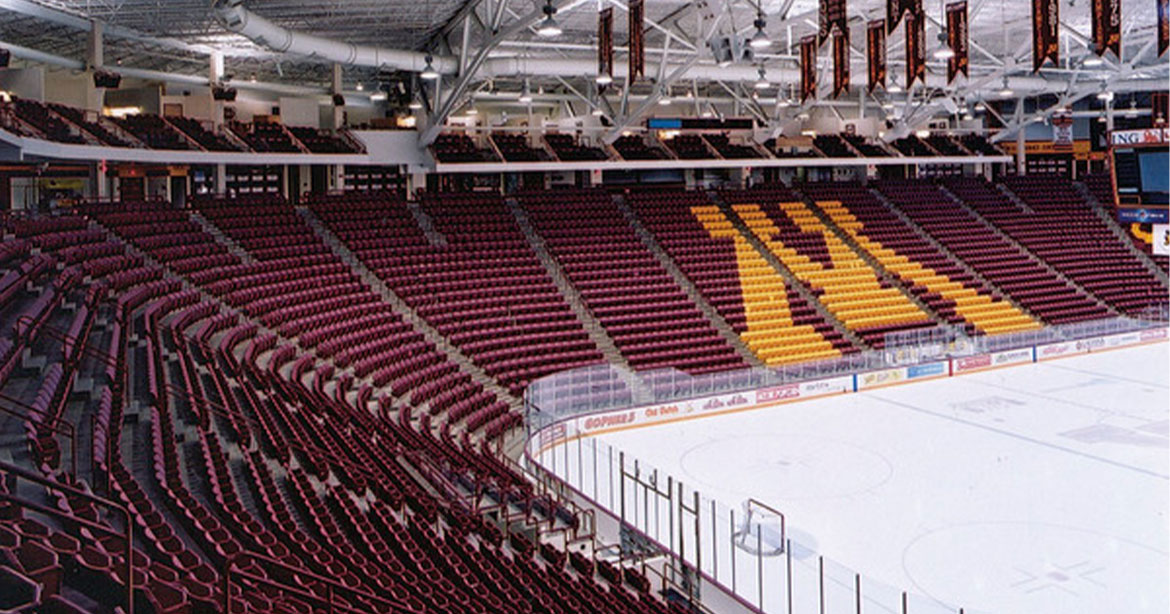
In today's world, sustainability is top of mind for most organizations and their stakeholders. With more resources being invested into sustainable solutions, it’s no surprise that we are seeing an increase in new construction and renovations that incorporate strong sustainability components.
Mortenson was recently tapped to renovate two university ice arenas that both included converting inefficient refrigerant systems to sustainable ammonia solutions. But converting an ice arena from traditional refrigerants, such as R22 or R134a, to more sustainable options like ammonia (NH3) or even CO2 (R744) involves several critical considerations that encompass technical, economic, environmental, and safety aspects. While converting can pose unique challenges, it can also give way to improved energy efficiency, environmental benefits, and compliance with evolving regulations.
Below are a few key factors and considerations before beginning a refrigerant to ammonia or refrigerant to CO2 conversion.
1. Cost Analysis vs Sustainability
One of the primary motivations for converting to ammonia is its lower environmental impact. Ammonia has both a Global Warming Potential (GWP) of zero and an Ozone Depletion Potential (ODP) of zero, making it an environmentally friendly alternative. Conventional refrigerants like R22 and R134a are also being phased out because they are no longer produced or imported into the U.S. (due to their high GWP and ODP), which is also driving arenas to make the change.
CO2 could also be gaining popularity soon, with the first CO2 rink installed this year at the Blue Jacket’s NHL facility. It's an attractive refrigerant choice for ice arenas due to its low GWP of one, an ODP of zero and its high energy efficiency in low-temperature applications (like ice). The use of CO2 aligns with global environmental regulations aimed at reducing greenhouse gas emissions by phasing out high-GWP refrigerants, and its growing adoption helps ice arenas meet current and future regulatory requirements.
However, initial costs for converting an ice arena to a more sustainable solution – whether that be ammonia or CO2 - can be significant due to the need for new equipment, system redesign, and safety enhancements. “While upfront costs may be pricier, ammonia or CO2 systems are more energy-efficient than traditional refrigerant systems, leading to reduced energy consumption, lower operating costs and maintenance over time,” says Julianne Laue, director of building performance at Mortenson. “The long-term savings in energy consumption and maintenance, combined with potential incentives for adopting environmentally friendly technologies, can offset the initial investment.”
2. Technical Compatibility + System Design
The technical feasibility of converting to ammonia or CO2 requires a thorough assessment of the existing system’s compatibility. Ammonia and CO2 systems operate at different pressure levels compared to many synthetic refrigerants. Therefore, the existing infrastructure, including compressors, condensers, heat exchangers, evaporators, piping, and valves must be evaluated for compatibility with different pressure levels. In many cases, components may need to be replaced or upgraded to handle the higher pressures and different thermodynamic properties of ammonia or CO2.
Designing an ammonia- or CO2-based system involves optimizing the refrigeration cycle to maximize efficiency and performance. This includes selecting compatible materials and components, designing for optimal heat exchange and minimal energy loss. What’s more, the system must be designed and incorporate monitoring technologies to maintain precise temperature control, which is crucial for ice quality in an arena setting.
Craig Flor, director of ice arena operations for University of Minnesota’s Mariucci and Ridder arenas, discusses the new Mariucci ice arena upgrades.
3. Safety Considerations
Safety is paramount in any conversion project. Ammonia, while environmentally benign, is toxic and flammable at certain concentrations. Proper ventilation systems, leak detection, and emergency response protocols must be established to protect personnel and the public. Additionally, ammonia systems must comply with stringent safety standards and regulations, such as those set by the American Society of Heating, Refrigerating and Air-Conditioning Engineers (ASHRAE) and OSHA. Comprehensive training for operators and maintenance personnel is also essential to ensure safe handling and operation of ammonia refrigeration systems.
While CO2 is non-toxic and non-flammable, it poses other safety challenges due to its high operating pressures and potential for asphyxiation in confined spaces. Safety measures such as pressure relief valves, robust system design, proper ventilation, and CO2 detection systems must be implemented to ensure safe operation. Training for personnel on the safe handling and operation of high-pressure CO2 systems is crucial to mitigate risks.
What’s more, renovating a facility and/or converting a system within an active space requires careful disruption avoidance planning. “We knew converting Mariucci and Ridder in two off-seasons would be challenging. The window of time to complete this project was very tight, especially since we were reducing the size of the rink in Mariucci which involved a new refrigeration system in a new location, new foundation work, and a new concrete slab under the ice to accommodate an indirect ammonia system,” says Craig Flor, director of ice arena operations at University of Minnesota. “We also replaced the dasher boards and modified seating. Mortenson’s planning, communication and schedule management gave us confidence each step of the way so we wouldn’t have unplanned disruptions and would be ready for the first game of the hockey season.”
Converting for the Long Haul
Converting an ice arena system from traditional refrigerants to ammonia or CO2 presents a compelling opportunity to enhance environmental sustainability, improve energy efficiency, and comply with existing and future regulatory requirements. However, it requires careful consideration of technical compatibility, safety measures and economic factors, and involving an experienced construction team with expertise in refrigeration can ensure a smooth transition and successful implementation.
By addressing these considerations, ice arenas can successfully transition to ammonia- or CO2-based refrigeration systems, benefiting from their long-term operational and environmental advantages.

Joe Pritzkow is a market executive focused on the Minneapolis market. He knows how to navigate collegiate and sports processes with ease and has a proven track record for delivering complex projects while meeting schedule and budget milestones.